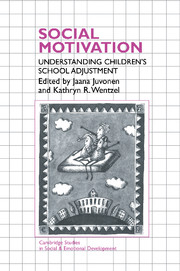Book contents
- Frontmatter
- Contents
- Contributors
- Preface
- Foreword
- 1 Introduction: New perspectives on motivation at school
- Part I Social motivation: Perspectives on self
- Part II Social motivation: Perspectives on relationships
- 9 Interpersonal relationships in the school environment and children's early school adjustment: The role of teachers and peers
- 10 Social goals and social relationships as motivators of school adjustment
- 11 Friends' influence on school adjustment: A motivational analysis
- 12 Peer networks and students' classroom engagement during childhood and adolescence
- 13 Academic failure and school dropout: The influence of peers
- 14 What's “emotional” about social motivation? A comment
- Author index
- Subject index
9 - Interpersonal relationships in the school environment and children's early school adjustment: The role of teachers and peers
Published online by Cambridge University Press: 22 October 2009
- Frontmatter
- Contents
- Contributors
- Preface
- Foreword
- 1 Introduction: New perspectives on motivation at school
- Part I Social motivation: Perspectives on self
- Part II Social motivation: Perspectives on relationships
- 9 Interpersonal relationships in the school environment and children's early school adjustment: The role of teachers and peers
- 10 Social goals and social relationships as motivators of school adjustment
- 11 Friends' influence on school adjustment: A motivational analysis
- 12 Peer networks and students' classroom engagement during childhood and adolescence
- 13 Academic failure and school dropout: The influence of peers
- 14 What's “emotional” about social motivation? A comment
- Author index
- Subject index
Summary
Young children face many challenges as they attempt to adjust to new school environments, including adapting to classroom routines, performing increasingly difficult academic tasks, and negotiating the complexities of interpersonal relationships with classmates and teachers. Although children's success at negotiating these challenges may be affected by many factors, most investigators have focussed on “internal” and organismic characteristics of the child when attempting to account for early school adjustment outcomes (e.g., gender, mental age, behavioral styles; see Ladd & Kochenderfer, 1996). Further, researchers have historically defined school adjustment in terms of children's academic progress or achievement. For this reason, much of what we know about the precursors of early school adjustment has come from research on the socialization of children's cognitive skills (e.g., Lazar & Darlington, 1982).
One consequence of this research tradition is that the construct of school adjustment has been defined rather narrowly, and the search for its determinants has been restricted. To address these limitations, we have attempted to elaborate upon earlier models of school adjustment in terms of (a) the hypothesized precursors of school adjustment and (b) the conceptualization of school adjustment itself (see Ladd, 1989; 1996). As illustrated in Figure 9.1, our model is based, in part, on the assumption that successful school adjustment originates both in the child (e.g., personality and behavioral styles) as well as in the interpersonal environment (e.g., the nature of his or her relationships with parents, teachers, and peers).
- Type
- Chapter
- Information
- Social MotivationUnderstanding Children's School Adjustment, pp. 199 - 225Publisher: Cambridge University PressPrint publication year: 1996
- 110
- Cited by



